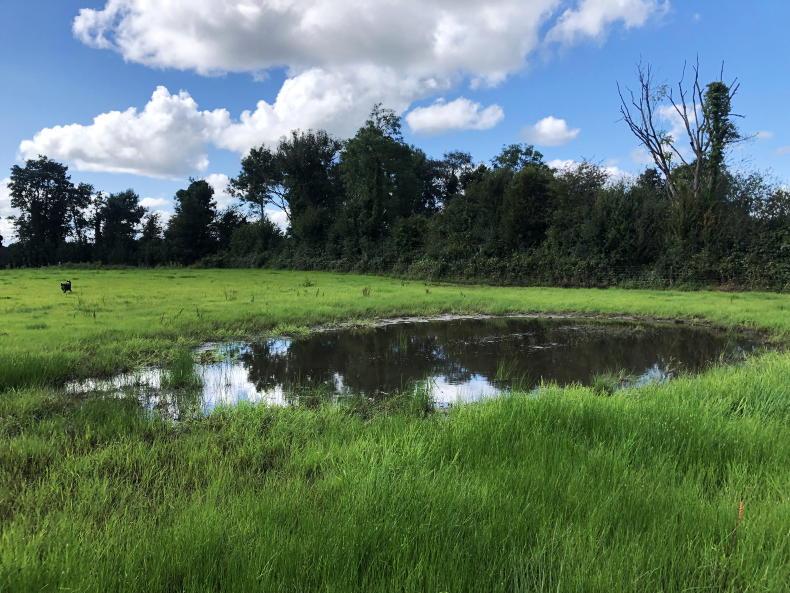Like many farmers around the country, Footprint Farmers Martin Crowe and Shaun Diver chose the ‘riparian buffer zone-grassland’ measure when applying for ACRES. Requiring minimal management and securing a payment of €1,530/ha/year over a five-year period, it’s an attractive measure.
Ecological benefits
A riparian zone is an area next to a waterbody (river, stream, lake, pond or land drain) where cultivation, spraying or the spreading of chemical or organic fertilisers cannot be carried out.
These zones are designed to reduce the potential for nutrients, sediment, pesticides, herbicides and other chemicals from entering water courses.
They also offer an opportunity to store carbon in soils and woody vegetation, and to reduce flood risk downstream by slowing run-off and enhancing infiltration.
Riparian zones can also form rich habitat for biodiversity, providing food and refuge for a wide range of birds, insects, and mammals.
For example, dense vegetation in riparian zones can be the perfect place for otters to create their above ground resting places, known as ‘holts’ or ‘couches’. Likewise, species-rich meadows on fertile flood plains, when allowed to flower and set seed, can safeguard native plants such as orchids, provide food for pollinating insects, and create feeding and nesting space for threatened birds such as curlew, snipe and meadow pipit.
Economic opportunities
Riparian zone measures in agri-environmental schemes are also a good example of how farmers can be justly financially rewarded for actions that benefit the wider community and future generations. While doing so, they offer farmers an opportunity to receive guaranteed annual income for land that is often less productive, wet, and can be difficult to maintain.

A shallow depression on a floodplain can form a natural wetland for wildlife, such as this one along the banks of the Clodiagh river on Tullamore Farm, managed by Footprint Farmer Shaun Diver.
Increasingly, there is also a degree of in-built flexibility in these schemes, meaning farmers can choose specifications that suit their land.
For example, in addition to the attractive rates for riparian buffer zone measures, ACRES offered the ‘riparian buffer strip-grassland’ measure, whereby farmers could receive payments of €1.30 - €2.11/m/yr for managing 1.5-6m wide riparian buffer strips, respectively.
While ACRES is now closed, the Native Tree Area Scheme is currently open for applications. It offers farmers an opportunity to receive payments for planting native trees as a riparian buffer zone of up to 2ha, with attractive payment rates of €22,840/ha over a 10-year
period.
Positive results
Martin has reported that since installing his pond and riparian zone in an area that was previously a steeply-sloped, rough
pasture, birdsong has noticeably increased.
He enjoys spending time there watching wildlife during the summer and, when hosting farm walks, uses the area to demonstrate how less productive land can be managed for nature, while still driving a profit.
At Tullamore Farm, Shaun was heartened to hear that water quality in the Clodiagh river has improved in recent years. He hopes that in managing some of the wet land on the floodplains of the river as a riparian zone, that he can help this trend to continue.
Name: Martin Crowe.
Farm size: 353ac (owned and leased).
Enterprise: Spring-calving dairy herd, rearing replacements.
Focus: Reducing nitrogen use, protecting water quality and increasing biodiversity while maintaining and increasing profit.
Schemes: ACRES; Soil Sampling and Analysis Programme; National Genotyping Programme; Liming Programme; Mulkear EIP (2019-2023).
Name: Shaun Diver.
Farm size: 180ac.
Enterprise: Beef and sheep.
Focus: IFJ demonstration farm; productivity and profitability; sustainability; building biodiversity.
Schemes: ACRES; SCEP; Sheep Improvement; ANC; Protein Aid.
Learn more
Invasive alien species
It’s crucial to identify what species are on your riverbanks or in your wetlands in order to know how best to manage them. This is particularly important when taking a ‘hands off’ approach to the management of an area, such as a riparian zone.
Alien invasive species (eg Japanese knotweed; Himalayan balsam; giant hogweed) can find their way into your watercourse, wetland or pond vegetation over time, and require swift action to prevent their spread. Simple to use mobile phone apps, such as Plant Net or Google Lens, can be used to quickly identify plants. The National Biodiversity Research Centre’s website (www.invasives.ie) has useful tips and resources on managing alien invasives.Top tips for managing riparian zones
If management is needed, it is best done on a rotational basis. Manage different sections of the riparian zone each year, so that there are always some sections left undisturbed for wildlife to retreat to.Maintaining a diversity of vegetation heights (ie grasses, scrub and trees) along the southern banks of rivers will benefit aquatic life by allowing light to reach the water in some areas while also creating cooler, shaded areas that will benefit fish and other species on hot days. For more information on ponds, wetlands and water quality solutions on Footprint Farms, scan these QR codes:


Like many farmers around the country, Footprint Farmers Martin Crowe and Shaun Diver chose the ‘riparian buffer zone-grassland’ measure when applying for ACRES. Requiring minimal management and securing a payment of €1,530/ha/year over a five-year period, it’s an attractive measure.
Ecological benefits
A riparian zone is an area next to a waterbody (river, stream, lake, pond or land drain) where cultivation, spraying or the spreading of chemical or organic fertilisers cannot be carried out.
These zones are designed to reduce the potential for nutrients, sediment, pesticides, herbicides and other chemicals from entering water courses.
They also offer an opportunity to store carbon in soils and woody vegetation, and to reduce flood risk downstream by slowing run-off and enhancing infiltration.
Riparian zones can also form rich habitat for biodiversity, providing food and refuge for a wide range of birds, insects, and mammals.
For example, dense vegetation in riparian zones can be the perfect place for otters to create their above ground resting places, known as ‘holts’ or ‘couches’. Likewise, species-rich meadows on fertile flood plains, when allowed to flower and set seed, can safeguard native plants such as orchids, provide food for pollinating insects, and create feeding and nesting space for threatened birds such as curlew, snipe and meadow pipit.
Economic opportunities
Riparian zone measures in agri-environmental schemes are also a good example of how farmers can be justly financially rewarded for actions that benefit the wider community and future generations. While doing so, they offer farmers an opportunity to receive guaranteed annual income for land that is often less productive, wet, and can be difficult to maintain.

A shallow depression on a floodplain can form a natural wetland for wildlife, such as this one along the banks of the Clodiagh river on Tullamore Farm, managed by Footprint Farmer Shaun Diver.
Increasingly, there is also a degree of in-built flexibility in these schemes, meaning farmers can choose specifications that suit their land.
For example, in addition to the attractive rates for riparian buffer zone measures, ACRES offered the ‘riparian buffer strip-grassland’ measure, whereby farmers could receive payments of €1.30 - €2.11/m/yr for managing 1.5-6m wide riparian buffer strips, respectively.
While ACRES is now closed, the Native Tree Area Scheme is currently open for applications. It offers farmers an opportunity to receive payments for planting native trees as a riparian buffer zone of up to 2ha, with attractive payment rates of €22,840/ha over a 10-year
period.
Positive results
Martin has reported that since installing his pond and riparian zone in an area that was previously a steeply-sloped, rough
pasture, birdsong has noticeably increased.
He enjoys spending time there watching wildlife during the summer and, when hosting farm walks, uses the area to demonstrate how less productive land can be managed for nature, while still driving a profit.
At Tullamore Farm, Shaun was heartened to hear that water quality in the Clodiagh river has improved in recent years. He hopes that in managing some of the wet land on the floodplains of the river as a riparian zone, that he can help this trend to continue.
Name: Martin Crowe.
Farm size: 353ac (owned and leased).
Enterprise: Spring-calving dairy herd, rearing replacements.
Focus: Reducing nitrogen use, protecting water quality and increasing biodiversity while maintaining and increasing profit.
Schemes: ACRES; Soil Sampling and Analysis Programme; National Genotyping Programme; Liming Programme; Mulkear EIP (2019-2023).
Name: Shaun Diver.
Farm size: 180ac.
Enterprise: Beef and sheep.
Focus: IFJ demonstration farm; productivity and profitability; sustainability; building biodiversity.
Schemes: ACRES; SCEP; Sheep Improvement; ANC; Protein Aid.
Learn more
Invasive alien species
It’s crucial to identify what species are on your riverbanks or in your wetlands in order to know how best to manage them. This is particularly important when taking a ‘hands off’ approach to the management of an area, such as a riparian zone.
Alien invasive species (eg Japanese knotweed; Himalayan balsam; giant hogweed) can find their way into your watercourse, wetland or pond vegetation over time, and require swift action to prevent their spread. Simple to use mobile phone apps, such as Plant Net or Google Lens, can be used to quickly identify plants. The National Biodiversity Research Centre’s website (www.invasives.ie) has useful tips and resources on managing alien invasives.Top tips for managing riparian zones
If management is needed, it is best done on a rotational basis. Manage different sections of the riparian zone each year, so that there are always some sections left undisturbed for wildlife to retreat to.Maintaining a diversity of vegetation heights (ie grasses, scrub and trees) along the southern banks of rivers will benefit aquatic life by allowing light to reach the water in some areas while also creating cooler, shaded areas that will benefit fish and other species on hot days. For more information on ponds, wetlands and water quality solutions on Footprint Farms, scan these QR codes:












 This is a subscriber-only article
This is a subscriber-only article










SHARING OPTIONS: